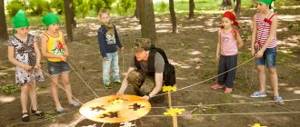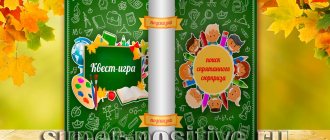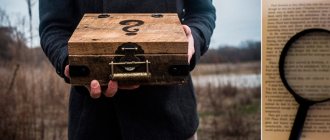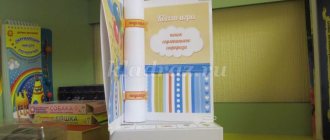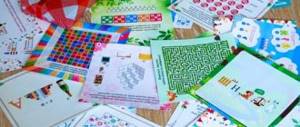Historical and legal quest - game for 9th grade
Historical and legal quest - game: “Knowledge of history and respect for the Constitution of your country is the first step towards a state of law”
Description: this development is for conducting a quest game for 9th grade students. Goals and objectives: - Consolidating the knowledge gained in social studies lessons through solving practical problems, repeating basic definitions and terms in the social studies course;
— Formation in students of the foundations of legal culture and education of civil responsibility; — Intellectual development of students through the study of the basic law of the state, development of creative abilities; — developing students’ skills in working with sources; analysis and synthesis of the studied material; classification; determining cause-and-effect relationships; applying knowledge in a similar situation; generalizations; conducting interdisciplinary (intercourse) connections; — Stimulating the development of legal and political youth through gaming technologies; — Education of patriotism and citizenship. — development of legal culture, patriotism and civic consciousness, stimulation of research activities of students. Progress of the game:
“Relying on the laws and also understanding their provisions is the only way to achieve agreement.”
Xun Tzu (313-238 BC), Chinese philosopher. — Musical intro “Where the Motherland Begins” The guys are divided into teams by lot, the captains receive route sheets.
Each team moves in search of the required station. Each station, for some of the participants, is a new discovery in the field of history or law. The ability to think logically, analyze, and work in a team helped the children achieve success. The points earned were recorded on an improvised key, which upon completion was used to open the chest with the last task. Each of the three chests contained a puzzle piece! From the fragments it was necessary to collect a photo of the President of the Russian Federation V.V. Putin. To do this, the teams had to guess to unite. Task 1. Greeting. It is necessary to break into teams and come up with a name and team motto in accordance with the theme of the legal game. The teams are being introduced. Task 2. Legal pictogram Pictograms are a picture letter in which some kind of message is encrypted. Participants of each team must encrypt 1 article of the constitution of their choice. — 4 min. They change tasks, and each team will be given 1 minute to guess which article encrypted in these pictures is about. Musical screensaver “Where the Motherland Begins” Task 3. quick survey (Each team has 10 questions, 1 point for the correct answer) Questions for the 1st team: 1. When was the current constitution of the Russian Federation adopted? (December 12, 1993). 2. In what form was the current Constitution adopted? (popular vote). 3.What is the correct name of our state? (Russian Federation - Russia, names are equivalent). 4.What is the name of the introductory part of the Constitution of the Russian Federation? (preamble). 5. Form of government in Russia? (republic). 6.What does the Constitution of the Russian Federation recognize as the highest value? (man, his rights and freedoms). 7.Who does the Constitution directly oblige to protect human rights and freedoms? (state, laws of Russia, president of Russia) 8. Source of power in the Russian Federation? (multinational people). 9.The people exercise power directly in the form of... (referendum and free elections). 10. What is another name for a republic, region, federal city, autonomous region and autonomous district? (subjects of the Russian Federation). Questions for the 2nd team: 1. How many autonomous regions are there in Russia? (one) Name it? (Jewish Autonomous Region). 2. Form of government in Russia? (federation). 3.A stable legal connection between a person and the state? (citizenship). 4. Who can deprive a Russian of his citizenship? (nobody) 5.Who can introduce internal customs borders between the constituent entities of the Russian Federation in Russia? (nobody). 6. The independence and mutual control of the legislative, executive and judicial powers implements the principle of ... (separation of powers). 7.Which bodies of democracy named in the text of the Constitution are not included in the system of state government bodies? (local government bodies). 8.What is the dominant religion in the Russian Federation? (it can not be). 9.Where are the foundations of the constitutional system of the Russian Federation outlined? (in chapter one). 10. At what age does a citizen of the Russian Federation have full legal capacity? (from 18 years old). Questions for the 3rd team: 1. State language in the Russian Federation? (Russian) 2. State symbols of the Russian Federation? (flag, coat of arms, anthem, capital). 3. Who appoints judges of the Russian Federation? (President in agreement with the constituent entities of the Federation). 4.Length of required residence on the territory of Russia required for election as President of the Russian Federation? (10 years). 5.How many deputy seats are there in the State Duma? (450). 6. The State Duma is elected, and the Federation Council..., name the word, (is formed). 7.Which government body can express no confidence in the government? (The State Duma). 8. Who is the guarantor of the Constitution of the Russian Federation? (The president). 9. Is it possible to participate in elections without being in Russia, but as a citizen? (Yes, by contacting the representative office or embassy of the Russian Federation). 10. Can a person who betrays his homeland be deprived of citizenship? (No, a citizen of the Russian Federation cannot be deprived of citizenship.) Task 4. human and civil rights and freedoms, part 1. “INSERT THE MISSING WORD.” (teams are tasked with inserting the missing words into the text about the Constitution of the Russian Federation) The Russian Federation - Russia - is a democratic, federal, ___________ state with a ___________ form of government. Recognizing, respecting and protecting _________________ is the responsibility of the state. The Russian Federation consists of republics, territories, cities of federal significance, __________, __________ - equal subjects of the Russian Federation. Every citizen of Russia has all ___________ on its territory and bears __________ provided for by _________. Correct answer: The Russian Federation - Russia - is a democratic, federal, rule of law state with a republican form of government. Recognition, observance and protection of human and civil rights and freedoms is the responsibility of the state. The Russian Federation consists of republics, territories, cities of federal significance, autonomous regions, autonomous districts - equal subjects of the Russian Federation. Every citizen of the Russian Federation has all rights and freedoms on its territory and bears equal responsibilities provided for by the Constitution of the Russian Federation. Task 5. Guess the term Based on the clues, determine which term found in the Constitution of the Russian Federation is being discussed. So: 1 term: (constitution) - Russian peasants believed that this was the name of Napoleon Bonaparte’s wife, - one of the meanings is construction; - in biology - individual physiological and anatomical characteristics; -in Latin - establishment; -in politics - the fundamental law of the state; 2nd term: (state) - has its own structure; -has its own special bodies to exercise its powers; -appeared in ancient times; -due to a dispute about who created it among the Slavs, the Normans or the Slavs themselves, Lomonosov had a fight with Bauer and was in prison; - it differs in the form of government, in the method of exercising power 3 term (republic) - originated in Ancient Greece; -in Latin - public business; -for her sake, Robespierre sent others to the guillotine and was executed himself; - this is a form of government; -can be parliamentary and presidential; Task 6. “Studying the Constitution.” Work in groups to study the text of the Constitution. — the first group works with Chapter 4 “President of the Russian Federation”. Assignment: Draw up a diagram of the “Powers of the President.” — the second group works with Chapter 5 “Federal Assembly”. Assignment: Fill out the diagram “Structure and powers of the Federal Assembly.” — the third group works with Chapter 7 “Judicial Power”. Assignment: Fill out the diagram “Courts of the Russian Federation”. Task 7
.
“Historical” (for speed) You can use the Internet. Question 1. This woman, who played a significant role in the history of Ancient Rus', was given one name at birth, another at baptism, and we know her by a third. Say this name. Answer: We are talking about the Russian princess, whom we know under the Varangian name Olga. Before her marriage, she bore the name Predslava, and after accepting Christianity, she bore the name Elena. Question 2. What was the last name of Dmitry Donskoy? Answer: He did not have any surname, since surnames appeared only a century later. Question 3. The Kremlin Armory houses the measured icon “John Climacus,” painted in 1554. What can you determine from this icon? Answer: The icon was painted in honor of the birth of Tsarevich Ivan, the son of Ivan the Terrible. A measured icon was an icon painted on a board in the size of a baby born into the royal family. Question 4. What did the most merciful Tsar Alexei Mikhailovich the Quietest often do such that his son, the stern Tsar Peter Alekseevich the Great, took a fine of 5 rubles? Answer: Alexei Mikhailovich often gave alms, while Peter the Great fought with the poor and with those who helped them. Question 5. It is known that the reforms of Peter I were received with hostility by the boyars, and the boyars were indignant against one of his decrees, caring about maintaining their status as a noble and rich woman. How did Peter I, by his decree, limit the opportunity to demonstrate their wealth and nobility? Answer: Peter I ordered to brush teeth, while previously teeth were blackened, thereby emphasizing that they ate a lot of sugar, which, due to its high cost, was available only to the rich and noble. Question 6. Under Peter I, a plant for the production of “potions” was built in St. Petersburg. The street on which he stood is now called Bolshaya Zelenina. Factories like this were called mills. Danish Ambassador Yul regarding the Russian potion The mortality rate at these factories was higher than at others. What did these factories produce? Answer: Gunpowder. Question 7. At this magnificent wedding one could see three Russian tsars at once. The groom was already reigning, but the groom’s two witnesses were just about to reign, one after 18 years, and the other after 26 years. Name all three kings. Answer: Ivan the Terrible, Boris Godunov, Vasily Shuisky. Question 8. Americans usually call Russians Ivans. We call the Germans Fritz and Hans, the French call them Michels. What did the ancient Slavs call the Varangians, who did not understand a word of Russian? Answer: Boobies (from Olaf). Question 9. On January 27, 1944, during a performance at the Bolshoi Theater, the action was suddenly interrupted, the curtain fell, the lights came on in the hall, and the director of the theater came to the front stage. After the reaction in the audience to his message, the opportunity to continue the performance appeared only half an hour later. What did the theater director say? Answer: About lifting the blockade of Leningrad. Question 10. I, I, II, I, VI, I, III, II, I, I, I, II, III... (Roman numerals) Complete the sequence. Answer: II (Nicholas II - the numbers make up the sequence of numbers of the Russian emperors). Question 11. The very first document about V.I. Lenin (Ulyanov) was signed by priest Vasily Umov and deacon Vl. Znamensky. What is this document about? Answer: About his birth Question 12. Leading the Roman legionnaires, he inspired terror in the countries to which he came. In 373, in Byzantium, he acquired an even more terrifying appearance. In 1497 he appeared in Russia. Erasmus of Rotterdam said about him: “He brings misfortune, disaster for everyone.” Who is he? Answer: Double-headed eagle. Captains competition. Journalism. You are a journalist, your task is to interview the school principal, what questions will you prepare for this dialogue. Task 8. Solve the crossword puzzle HORIZONTALLY: 1. By-law issued by the president 2. Regulatory legal act issued by the legislative body. 3. Independence of the state in external affairs and supremacy in internal affairs. 4. Influence based on law or tradition, i.e. non-physical influence exerted on other people within the framework of the law. 5. The most active part of the class, united in a political organization and expressing the interests of its class. 6. Head of state in countries with a republican form of government 7. A legal act issued by the government. 8. Introductory part of a regulatory agreement or regulatory act. 9. One of the names of a normative legal agreement (often an international one). 11. One of the forms of government 10. A stable union of states, independent only within the competencies distributed between them and the central government by the federal constitution. VERTICAL: a normative act that has the highest legal force in the state. Answers to the crossword puzzle: 1.decree 2.law 3.sovereignty 4.power 5.party 6.president 7.decree 8.preamble 9.convention 10.federation 11.democracy CONSTITUTION Task 9
.
Encryption Decipher the abbreviations that are often found in legal documents of a domestic and international nature: EU - European Union Labor Code of the Russian Federation - Labor Code of the Russian Federation RF IC - Family Code of the Russian Federation CIS - Commonwealth of Independent States State Duma of the Russian Federation - State Duma of the Russian Federation SAC RF - Supreme Arbitration Court Russian Federation Constitutional Court of the Russian Federation - Constitutional Court of the Russian Federation Civil Registry Office - Civil registration UN - United Nations Criminal Code of the Russian Federation - Criminal Code of the Russian Federation Task 10. Fairy-tale 1. In which fairy tale does a person in all respects gray carry out a plan to kill two persons and only thanks to With timely public intervention, does everything end well? (“Little Red Riding Hood”) 2. In this fairy tale by Pushkin, an official grossly violated the principle “from each according to his ability, to each according to his work” and appropriated the worker’s salary. The worker committed lynching, causing serious bodily harm to the official, leading to death. (“The Tale of the Priest and His Worker Balda”) 3.Name a fairy tale in which a person with a bad reputation, under the guise of a sweet and charming person, made an attempt on the lives of seven minor souls, but was exposed and severely punished. (“The Wolf and the Seven Little Goats”) 4. This tale is about a certain athlete who, without good physical preparation, went to an obstacle course competition. Cunning and endurance allowed him to approach the very finish line. The ending is tragic: the hero, violating safety rules, dies. (“Kolobok.”) 5.Name a fairy tale where two daughters-in-law of the king encroach on the property of the third, steal the robe of the bride of the king’s youngest son and burn it. (“The Frog Princess.”) 6. In this fairy tale, a good bird gave up its property to two persons who wanted to divide it into parts, but managed to do so. As a result, the wealth was accidentally destroyed by a petty gray person. (“Chicken Ryaba.”)
We recommend watching:
Crossword puzzle with answers for students in grades 8-9 “The First World War” Summary of a history lesson in grade 9 with presentation. World War II Summary of a history lesson in 9th grade “The Great Patriotic War” Summary of a history lesson for 9th grade on the topic: The Soviet rear during the Great Patriotic War
Similar articles:
Optional course program for students of grades 9, 10, 11 on the history of Kazakhstan
Lesson summary on Modern History in 9th grade
Test on the history of Russia for grade 9 on the topic: “The USSR on the path to building a new society”
Local history quest - game “Through the streets of my native village”
O
Appendix 5.
As the years passed, the population of the village grew. The old wooden building could no longer accommodate everyone. And then a new two-story brick building was built with a large assembly hall, a room for a library, rooms for classes of various clubs, and a gym.
Appendix 6.
R
The Shilykovo land is generous for talented people! Idea Grigorievna Andreeva lives in one of the houses. This woman is known for writing poetry about her native village and the people inhabiting it. She is a frequent visitor to the school, where she reads her works at meetings with the children. Several books of her poems have been published. Idea Grigorievna raised and raised two children and five grandchildren. Now she has two great-grandchildren. Near I. G. Andreeva’s house, look for the next letter.
Appendix 7.
L
The next letter is located near one of the oldest buildings in our village. It once housed a library and a dormitory for poultry factory workers. At one time there was a bar here.
Appendix 8.
A
The hard times spared no one. It also affected our village. Of the 40 people who went to the front of the Second World War, only 22 people returned to the village. In 1974, a monument to fellow countrymen who did not return from the war was built in the village of Shilykovo. For the 70th anniversary of the Victory, the monument was reconstructed. You will find the next letter near the monument to the fallen.
Appendix 9.
IN
Your path lies to the building, which celebrated its 40th anniversary in January 2021. It was put into operation in December 1977, and the first classes began after the winter holidays. The first director was Evgeniy Ivanovich Boldyrev, who worked in this position until 2009.
Appendix 10.
X
From the letters you need to make up the surname of a woman who worked for many years at the Ivanovo poultry farm and has the title of Hero of Socialist Labor.
(KHARLAMOVA)
Appendix 11.
Angelina Petrovna Kharlamova
(born 1939) - worker in Soviet agriculture, foreman for raising chickens at the Ivanovo poultry farm, Hero of Socialist Labor.
Born on March 20, 1939 in the village of Sosnovka, Lezhnevsky district, Ivanovo region, into a peasant family. Russian. She graduated from 7 classes in the village of Cherntsy, then from the Shuya Agricultural School.
She began her career at the Soglasie state farm as a calf cow and milkmaid. In 1960, she worked on the construction of buildings for a new poultry farm in the village of Shilykovo. Since 1961, she remained to work as a poultry worker at a new poultry farm, called Ivanovskaya. First in the chicken rearing workshop, then moved to the lagging breeding stock workshop. In a short period of time, she achieved good results - each laying hen began to produce not 165 eggs per year, but 230 or more. She combined work in production with correspondence studies at the Yuryevets Agricultural College.
